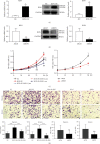RON Mediates Tumor-Promoting Effects in Endometrial Adenocarcinoma
- PMID: 34712728
- PMCID: PMC8548096
- DOI: 10.1155/2021/2282916
RON Mediates Tumor-Promoting Effects in Endometrial Adenocarcinoma
Abstract
Endometrial adenocarcinoma is one of the most prevalent female reproductive tract cancers in the world, and the development of effective treatment is still the main goal of its current research. Epithelial-mesenchymal transition (EMT) plays a significant part in the occurrence and development of epithelial carcinoma, including endometrial adenocarcinoma. Recepteur d'origine nantais (RON) induces EMT and promotes proliferation, migration, and invasion in various epithelial-derived cancers, but its role in endometrial adenocarcinoma is still poorly studied. The purpose of this study is to verify the overexpression of RON in endometrial adenocarcinoma and to explore its specific roles. RON expression in tumor lesions was verified by immunohistochemical staining, HEC-1B cells were used to construct stable cell lines with RON overexpression or knockdown to investigate the effects of RON on the function of endometrial adenocarcinoma cells, and xenotransplantation experiment was carried out in nude mice to explore the effect of RON on the growth of endometrial adenocarcinoma in vivo. This study revealed that RON could promote the proliferation, migration, and invasion of HEC-1B cells and induce EMT, and these effects were regulated through the Smad pathway. RON overexpression could promote growth of endometrial adenocarcinoma cells in nude mice, while its inhibitor BMS777607 could restrict this role. RON played an important role in endometrial adenocarcinoma and had a potential to become a new therapeutic target for endometrial adenocarcinoma.
Copyright © 2021 Qin Yu et al.
Conflict of interest statement
The authors declare that there is no conflict of interest regarding the publication of this paper.
Figures





References
MeSH terms
Substances
LinkOut - more resources
Full Text Sources
Molecular Biology Databases

